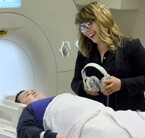
Child Life specialist Mollie Young
MRIs had become a concern for 9-year-old Tyler Freeman, close to a deal-breaker. For him, normal life can hinge on head and spinal scans that can add up to two hours in the MRI suite. Since age 2, when he was first diagnosed with Langerhans cell histiocytosis (LCH), he’s undergone up to four MRIs a year to try to keep the rare blood disorder in check.
Scans are crucial for LCH patients. Though the disease can lie dormant, when it’s active it sparks painful, eroding tumors. Tyler lost hearing in one ear after LCH claimed its mastoid bone. His skull and spine have also been affected. “Our fear is that it can enter the brain,” says grandmother Patti Freeman.
Yet last summer, the young man balked at undergoing a full MRI without anesthesia, then refused outright. This February, however, Tyler took to the MRI, apparently without qualms. The presence of Child Life specialist Mollie Young made all the difference.
“A Child Life specialist can use a variety of tools and techniques to sooth a child’s worries and give them much-needed distraction from the actual scan,” says Thierry Huisman, director of Pediatric Radiology at the Johns Hopkins Children’s Center. The approach has dramatically reduced the number of kids needing general anesthesia for MRIs at Johns Hopkins. A recent study Huisman led showed that half of 229 young patients with MRIs lasting an hour or less could forego sedation.
Young was recruited by Huisman as part of his “crusade”—his word—to lessen sedation. Together, they shaped a protocol that tapped Young’s gifts to connect with children and suss out concerns. While Young is the face of the protocol, she is also part of a team that includes radiologists, imaging technologists, nurses and patient care coordinators, all of whom work in synchrony to reduce anesthesia use. The team reviews all incoming MRI orders and triages them to Young, who plucks out the ones she deems promising for sedation free imaging. The evaluations pull on her background in child development and psychology.
“You just dig in your feet and apply it in a way that’s immediate,” Young says. An initial phone contact with the family, she adds, can tell how a child copes with the unfamiliar, follows instructions and processes information: “Knowing temperament is hugely important, along with preexisting fears or past experiences.”
Some situations demand anesthesia, she says—“if a child is neurologically devastated and nonverbal or unable to process information—someone after a severe accident, for example.” Otherwise, rules for who foregoes it aren’t hard and fast.
“We’ve had an awake 4-year-old lie still for an hour and a half MRI without moving,” says Young. “Kids with autism or Down syndrome can do this perfectly, as well as those with ADD or ADHD if properly prepared.” For some, low-dose valium to reduce anxiety plays a part.
Once families arrive, allaying fears and tailoring the experience becomes a focus. She deals with the magical thinking of young ones, who believe their heads will be opened like a suitcase. Kids worry about being stuck in a tube. “We show them that our MRI is wide, open at the ends and bright, that a parent is right there with them.”
And yes, it is noisy, but Young lessens worrisome perceptions with handpicked music or programs in their headphones. Tyler had the need to know there could be a short sitting-up break in the scan—long enough for his grand-mom to knead his injured back. For him, finishing this latest MRI without sedation was an Olympic gold, says Young. Adds Patti Freeman, “We call it a blessing.”
##
